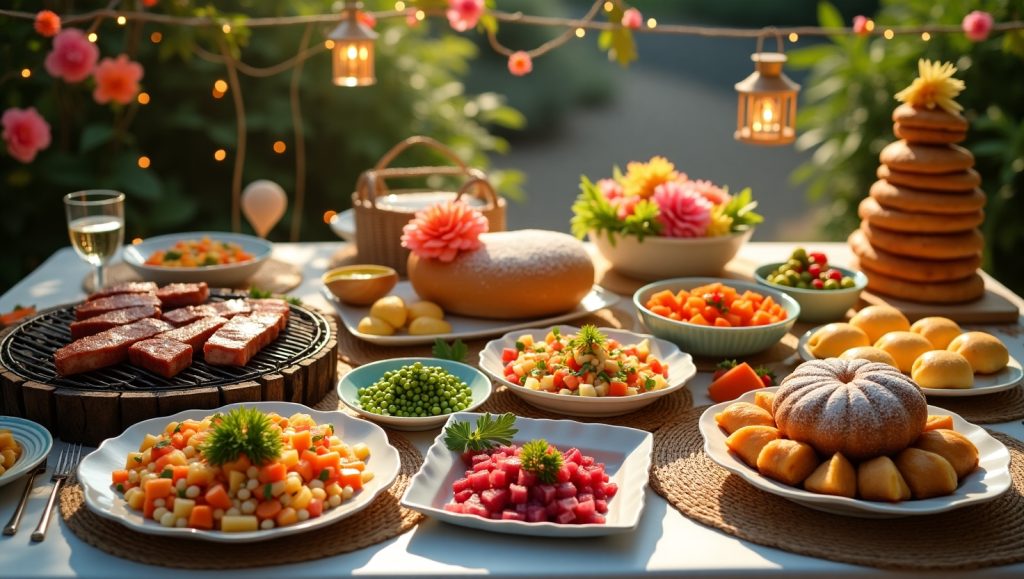In Argentina, Santa Claus is called Papá Noel. He brings the Christmas spirit by giving gifts to children on Christmas Eve. This tradition reflects Argentina’s Spanish roots and fits well with local customs that focus on family and celebration.
Papá Noel’s role as a gift-giver in Argentina shows how different cultures celebrate Christmas in their own unique ways. This observation tells us a lot about Argentina’s rich cultural mix.
How do you think this compares to Christmas traditions in other countries?
Celebrating Christmas in Argentine
In Argentina, Christmas is all about family, faith, and bright decorations. The holiday season kicks off on December 8 with the Feast of the Immaculate Conception, a day filled with spiritual meaning.
Family is the Heart of It All
Christmas Eve is more important than Christmas Day. Families gather for a big dinner that starts late and stretches into the early hours. Midnight is marked by hugs, sparkling cider, and bursts of fireworks.
Summer Vibes, Not Snowflakes
Forget ugly sweaters. Christmas in Argentina means backyard barbecues, cold drinks, and children running around in shorts. It’s a tropical twist on a holiday often tied to winter.
The Nativity and Catholic Influence
Many homes display detailed nativity scenes. Though gift-giving is popular, religion plays a strong role, with masses and prayers forming the spiritual backbone of the celebration.
Traditional Argentine Christmas Food
In Argentina, Christmas food is a blend of Spanish, Italian, and local traditions. It’s really a mix that brings out a lot of flavors.

Asado and Cold Platters
The classic Argentine barbecue, or asado, often headlines the meal. Alongside it, you’ll find cold dishes like vitel toné (veal with tuna sauce) and Russian salad, perfect for the summer heat.
Sweet Endings
No meal is complete without panettone, turrón, or mantecol. These traditional desserts pair perfectly with cider and signify the sweet ending to a long, laughter-filled night.
Homemade Touches
Empanadas, stuffed eggs, and homemade flan are also common. Every family adds their own spin, keeping the celebration both personal and rooted in tradition.
Discover surprising Spanish vocabulary that starts with the letter K.
Christmas Morning, Gifts, and Beyond
In Argentina, Christmas morning is all about giving gifts and spending time with family. Everyone gathers for a relaxed brunch. Throughout the day, the sound of laughter and music fills the air, making everything feel more festive.

Modest Gift Traditions
Gifts are usually opened after midnight or early in the morning. Presents tend to be modest, emphasizing love and thoughtfulness over materialism.
A Quiet Morning
Unlike the chaos of Eve, Christmas morning is slow and peaceful. Families sleep in, then enjoy breakfast together, often with leftover sweets and hot mate.
Beach and Family Time
Given the summer heat, many families spend the day outdoors, either heading to the beach or relaxing in gardens. The focus shifts to bonding and unwinding.
Decorations Christmas in Argentina
In Argentina, Christmas decorations are bright and colorful. People really go all out with lights and ornaments at home, on the streets, and in public places. It feels joyous everywhere, capturing the lively culture and shared holiday spirit.
Nativity Scenes Over Trees
Though Christmas trees are used, nativity scenes are more meaningful and widely displayed. They’re often detailed, with lights and miniature villages.
Lights and Fireworks
Houses light up with colorful lights, but the real show comes from the fireworks at midnight. The sky becomes a stage for celebration.
Homegrown Flair
Many decorations are handcrafted, especially in rural areas. Paper ornaments, garlands, and locally inspired decor add a personal and cultural touch.
Activities leading up to Christmas
In the weeks before Christmas, Argentinians get ready in many ways.
Christmas Markets and Street Fairs
Some cities host festive markets, with local crafts, food, and music. They capture the community spirit and offer gifts with a local touch.
Church and Spiritual Events
Masses and spiritual events begin early. Many attend novenas or special services, adding a sacred rhythm to the otherwise lively days.
Family Preparations
Families come together to cook, clean, and decorate. Children get involved too, making ornaments or writing wishes, keeping the excitement alive.
Argentina’s Christmas – A Blend of Past and Present
Argentina’s Christmas celebrations blend old traditions with new ones, showing off the country’s rich culture. It starts on December 8 with the Feast of the Immaculate Conception. People decorate with bright lights and colors.
Colonial Roots and European Influence
The celebration has roots in Spanish colonial traditions and later waves of European immigration, especially from Italy. These influences remain strong in food, music, and rituals.
Local Culture Shapes It
Tango music, gaucho customs, and Argentine hospitality give Christmas its distinctive flair. It’s not just about the holiday – it’s about being proudly Argentine while celebrating it.
Evolving with Time
While old traditions hold strong, younger generations are blending them with global trends. Social media, pop music, and modern gifts mix with religious rituals and family traditions.
Christmas Traditions Around the World
Christmas customs differ all over the world, reflecting each country’s unique culture and history.

Europe’s Wintry Wonderlands
In Germany and Austria, Christmas markets, gingerbread, and snow define the season. Midnight mass and nativity plays bring communities together.
Asia’s Unique Adaptations
In Japan, Christmas is more romantic and commercial, with fried chicken and light shows. The Philippines has long novena masses and parol lanterns lighting up the streets.
Africa and the Southern Hemisphere
Like Argentina, countries like South Africa and Australia celebrate in summer. Beach barbecues, concerts, and open-air services are common.
Want to master the Present Perfect in Spanish? Start here.
How is Santa Claus known around the world?
Santa Claus goes by different names and looks different depending on where you are in the world. In the UK, people call him Father Christmas. In France, he’s known as Pere Noel. In Germany, they say Weihnachtsmann, and in Russia, it’s Ded Moroz.
| Country/Region | Name of Santa Claus | Cultural Description |
|---|---|---|
| Argentina | Papá Noel | Dressed in red but adapted for summer, Papá Noel appears in malls and parades. Children leave letters and shoes out, hoping for gifts and sweet treats. |
| Netherlands | Sinterklaas | Arrives by steamboat from Spain in early December. Children leave out shoes with carrots for his horse, and receive gifts on Saint Nicholas’ Eve. |
| Russia | Ded Moroz | Known as Grandfather Frost, he arrives with his granddaughter Snegurochka on New Year’s Eve, bringing gifts and magical winter cheer. |
| Italy | La Befana | A kind witch who delivers presents on January 6th, Epiphany. Children hang stockings, and good behavior is rewarded with candy and small toys. |
| Japan | Santa-san | A cheerful, Western-style Santa who brings joy to children. Though not religious, Christmas is celebrated with decorations, gifts, and fried chicken. |
Conclusion
In Argentina, Santa Claus goes by the name Papá Noel. He brings the Christmas spirit by giving gifts to kids on Christmas Eve.
Christmas in Argentina is a mix of old and new traditions. It’s about family and celebration. They have special foods and decorations that show the rich history and culture of the country. It’s a unique way to celebrate, bringing together the past and present.
Transform nerves into confidence at Lingua Viva public speaking sessions.
Born in Cali, but raised in London, Juan Pablo has led an interesting life. He has an undergraduate degree in Foreign Language and 10+ years of experience. Juan Pablo has taught and worked as a professor and interpreter in Spanish, English, and French languages. He prides himself on having a ‘situational teaching style’, which means he caters lessons to fit student needs. He is serious about teaching, responsible, professional, clear, and concise.











